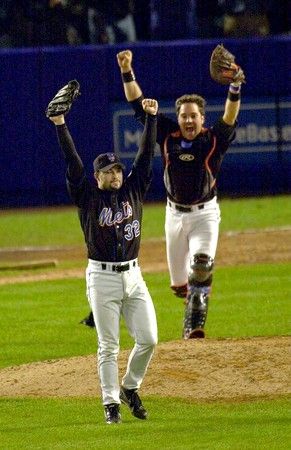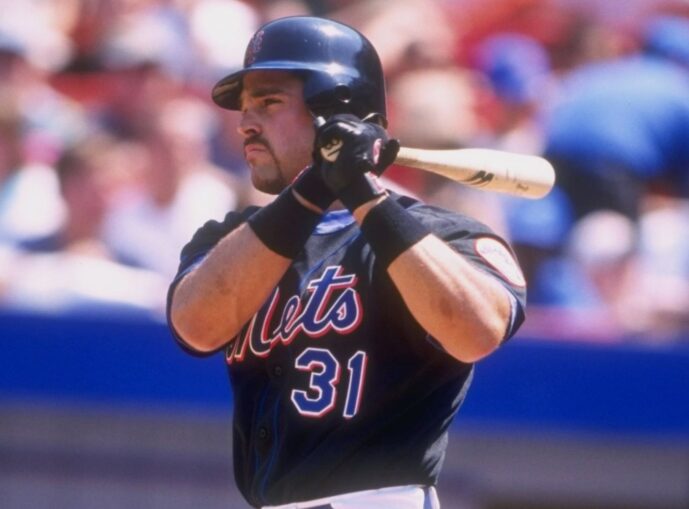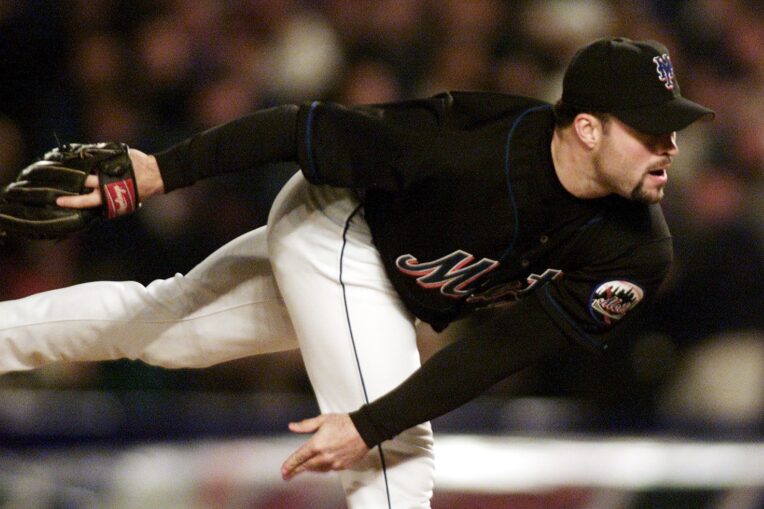
Cue the Baha Men. The Mets embraced this one-hit wonder musical group’s top track during the postseason, as most of the country did in the summer. They even allowed them to alter “Who Let the Dogs Out?” with a Mets theme.
And speaking of things that were confined to the year 2000, Mike Hampton in New York had already been considered a success by the time October arrived. He was a solid 15-10 with a 3.14 ERA during his lone regular season in New York, but truly solidified his acquisition from Houston the previous winter with a dominant League Championship Series in which he would be justifiably named the Most Valuable Player.
Hampton strung together 16 consecutive scoreless innings against the St. Louis Cardinals, including a brilliant three-hit shutout in the clinching Game 5. It ended with Rick Wilkins hitting a high fly to Timo Perez, bounding up and down in joy before hauling in the clinching out. The players rushed to embrace Hampton. Robin Ventura got there first and lifted up their hero.
Mike Piazza, Todd Zeile, and Todd Pratt got there next before the rest of the players joined in the mob. The Baha beat blared through the extra speakers installed at Shea Stadium. Confetti fell from the rafters. John Franco, Piazza, and others took a victory lap around the field to thank the fans. The Mets were in the Fall Classic for the first time since 1986. And with the team across town leading in their Championship Series on the American League side, what may lay ahead would be more than just a World Series to the people of New York. The fans and the city couldn’t contain their excitement. Even the players were hinting at their feelings.
“We’re happy to go [to the World Series],” Ventura said. “It would be nice to stay home, though.”
It was the first postseason meeting between the Mets and Cardinals, but not the first time they had clashed with high stakes.
New York and St. Louis had developed a bitter rivalry during the mid-to-late 1980s, a period when both occupied the NL East and both competed for the lone playoff spot out of that division. The Mets prevailed in ’86 and ’88. The Cards captured the flag in ’85 and ’87. The Mets’ strengths centered on slugging and pitching, opposed by the Redbirds’ speed and defense.
There were far fewer contrasts in styles by the turn of the century. Both teams possessed serious run-producers. The Cards had an MVP candidate in Jim Edmonds and the single-season home run king in Mark McGwire, except the latter was limited to a pinch-hitting role because of patellar tendinitis in his right knee.
By the time this NLCS had run its course, the Mets’ strengths were accentuated and the Cardinals’ weaknesses were exploited.
One crucial element in New York’s postseason drive was a complete unknown to even the most astute Mets fan less than two months ago. As late as 1999, Perez was a member of the Hiroshima Toyo Carp in the Japan Central League. By September 2000, he was called up to the majors – replacing the injured Derek Bell. Perez impressed enough in that final month of the regular season to earn a spot on the playoff roster.
He batted .294 and drove in three runs in the Division Series win over San Francisco and was of even greater impact against St. Louis, scoring eight runs in five games. He didn’t waste time, either. Leading off the NLCS opener, Perez doubled to right field off Darryl Kile. A wild pitch sent Timo to third. A walk put Edgardo Alfonzo on first, and the opportunity was ripe for New York’s mammoth bat to awaken. Piazza was, for all intents and purposes, a non-factor against the Giants. He came up 18 times, was retired 15 times, and delivered just one extra-base hit.
But any notion of a slump was dispelled with a vicious swing. Piazza jumped on Kile’s first offering and pulled it to left field. Perez scored easily, Alfonzo advanced to third. “The monster is out of the cage!” bench coach John Stearns bellowed – picked up by his mic on the FOX broadcast that evening. Robin Ventura followed with a sacrifice fly.

While the Cardinals’ starter failed to prevent the New York advance, Mets starter Hampton deftly avoided any St. Louis response. He escaped a first-inning bases-loaded situation, walked one in the second but stranded him, and allowed a single and wild pitch in the third – but no more. New York built its lead to 3-0 when Hampton exited, and 5-0 when Armando Benitez came in to finish it off. Not helped by sloppy fielding, which led to two unearned runs, the Mets wrestled home-field advantage away.
New York continued to silence the loyalists in St. Louis the next night, scoring two right from the jump. This was aided by troubling developments from young hurler Rick Ankiel, who encountered wildness in the NLDS. Five pitches sailed past Eli Marrero. With each offering that sailed to the backstop, the more sympathy he incurred from the viewing audience – watching a promising pitcher lose control. Alfonzo, Piazza, and Ventura each walked. Todd Zeile brought in one run on a sacrifice fly and Benny Agbayani drove another in with a double. Ankiel was done having thrown just 20 pitches and retiring two batters.
The Mets had Game 2 under control into the fifth, until Al Leiter stumbled. Doubles from Edgar Renteria and Fernando Tatis tied the score at three apiece. New York struck back in the eighth with RBI singles from Alfonzo and Zeile. But the bullpen and the defense quickly relinquished what its team had just gained. John Franco allowed a walk, single, and wild pitch which led to one run. Turk Wendell came in and watched as J.D. Drew slashed a base hit to center field. Jay Payton overran the ball and that small miscue allowed the lead-footed Will Clark to make it home.
The pendulum on this back-and-forth affair swung another time (and the last time) in the top of the ninth. Ventura reached on an error by first baseman Clark. After a sac bunt and Joe McEwing entering to run for Robin, Payton atoned (and delivered his second game-winning hit of the playoffs) with a single up the middle. Edmonds, a Gold Glove extraordinaire, found fielding to be unexpectedly difficult himself on the Payton smash. As McEwing raced home, the ball bounded and nicked the heel of Edmonds’ glove and rolled behind him – allowing Payton to reach third. The Mets didn’t push across any insurance runs, but Benitez found little trouble in closing out the Cardinals and taking a 2-0 series lead back to Queens.
Now at Shea, it was the Cardinals’ opportunity to get the jump. Facing Rick Reed, a pitcher they owned this season with eight runs over two starts, St. Louis tallied a pair of first-inning runs. Andy Benes kept the Mets from coming back and kept the depleted Cards bullpen rested for much of the afternoon. In truth, after five exhilarating victories in a row, the Mets were due for a slight fall from grace. The Game 3 loss, an 8-2 defeat, proved to be just a brief respite on New York’s charge to the pennant. The Mets recharged on offense – scoring 17 runs over the final two games (giving them 29 in their four victories and 31 for the series) to overwhelm St. Louis and solidify their National League title.
In spite of a road team again scoring two runs in their initial turn at-bat, the fourth straight instance this happened, New York had a resounding answer in the bottom of the first – and an even more impressive streak to offer.
Darryl Kile, pitching on three days’ rest, started to see double. Then another. Then another. And then another. The Mets opened their half of the inning with four straight two-base hits – beginning with Timo Perez, continuing with Edgardo Alfonzo and Mike Piazza, and ending with Robin Ventura.
After a one-batter break, Benny Agbayani made it five doubles for the inning – his scored Ventura and capped a four-run frame. Bobby Jones‘ struggles were fortunately masked by New York’s 10-run outburst. The explosion included a rocket launch from Piazza which was sent into the Mets’ bullpen.
With a 3-1 series lead and the offense clicking as well as it had all year, the team exuded utmost confidence. Nobody better exemplified that than the pitcher who won Game 1 and was tabbed by manager Bobby Valentine to take the mound for Game 5.
“I’m looking forward to pitching the game of my life,” Mike Hampton said.
He was true to his word. Exceptionally so. As the Mets bats embarked on another productive night, Hampton was locked in. Unlike his opening game start, he had very little difficulty getting through the St. Louis order. Todd Zeile’s bases-clearing double off the right-center field wall brought home Timo Perez, Piazza, and an unusually excited Robin Ventura. The Shea crowd reacted in kind. With New York now up 6-0 in the fourth and Hampton on cruise control, it was a preemptive celebration.
The only tarnish on an otherwise immaculate 7-0 win came during the Mets’ final turn at-bat. Jay Payton dug in versus Dave Veres, then collapsed to the ground after being drilled in the helmet. Payton quickly arose and furiously walked towards the mound before being held back by Eli Marrero. Benches cleared – more to de-escalate a situation that could’ve turned far more costly to the Mets than the Cards. With a scar plainly visible above Payton’s left eyebrow and blood streaming down the side of his head, Payton relented.
A few minutes later, there was another, more joyous gathering near the mound – but only the New Yorkers were there. Thirty-one years to the day the 1969 Mets celebrated their World Series triumph, the Mets of the 21st century had initiated a party of their own.
All that was left was to find out which team they’d face. As it turned out, they didn’t have to look far to find them.
















